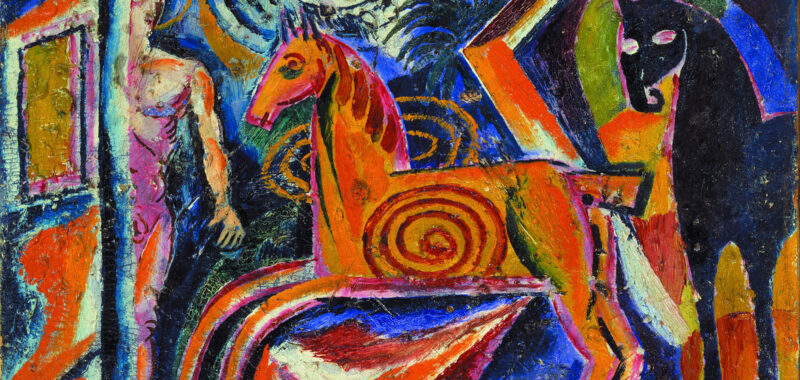LONDON — The story of a nation’s origins can be so much messier than the day-to-day of its politics. Things get papered over, then leak out between the cracks.
In the Eye of the Storm: Modernism in Ukraine, 1900–1930s at the Royal Academy conveys how Ukraine came to be a thriving center of avant-garde art in the early decades of the 20th century, absorbing and refashioning its own versions of Cubism, Futurism, and Constructivism. Most of the works in the show are on loan from Ukraine’s National Museum and the Museum of Theatre, Music and Cinema of Ukraine.
The exhibition relates a version of the history of modernist painting in Ukraine that has been little told before, one that skews toward the notion of Ukraine not as a vassal state subject to malign imperial designs, but as a nation that had been striving, since at least the mid-19th century, to realize its dreams of self-determination. A sense of fluidity permeated its art world — artists came and went, traveling from country to country — as well as an exciting experimentalism that even animated such fields as theater design.
Dreams of nationhood can be thwarted, but also obscured. We’ve all heard of Kazimir Malevich, Suprematist painter of “Black Square” fame, the man who injected heady notions of spirituality into abstract art in the early 20th century. And of a Parisian called Sonia Delaunay, who developed Simultanism with her husband, Robert.

In the relatively recent past, we have generally been persuaded to think of Malevich as a member of the Soviet avant-garde. Tate Modern’s 2014 catalogue on the occasion of a great gathering of his works describes him as having “come of age in Tsarist Russia.” Not so here. Malevich is identified (like all other artists in this show) by his Ukrainian name: Kazymyr Malevych. Born in Kyiv to a Polish family, he grew up in the countryside, and local folk traditions were very close to home, as they were to so many of the artists on view. As for Delaunay, she is generally remembered as a celebrated member of the Parisian avant-grade. Except that she was no more French than Malevich was Soviet. Sonia Delaunay was of Ukrainian origin too; born in Odesa, she spent her childhood in the country.
But many lesser known artists are in the exhibition as well, whose names do not deserve to be forgotten — Alexandra Exter, for example, whose career as an artist saw her shuttle from Kyiv to Paris and then back again; “Bridge (Sevres)” (c. 1912), a painting of restrained palette, is squarely camped out in Cubist terrain. Or Oleksander Bohomazov, who taught at the Kyiv Art Institute from 1922 to 1930. His 1927 painting “Sharpening the Saws” is one of the show’s most remarkable works because it aligns itself with many other Socialist Realism paintings of the ennobled worker, but its sense of geometry and brilliant use of color refresh that tired genre — see how the three saws fan out? The work is a nod, surely, to more local folkloric traditions.
And then it all ended. Stalin’s purges of the 1930s — that brutal extirpation of so many “bourgeois nationalists” — did the dirty work of the administration; movement and fluidity suddenly shifted to the unanswerable rigidity of death. This incredible exhibition rescues an under-documented historical moment from near oblivion.





In the Eye of the Storm: Modernism in Ukraine, 1900–1930s continues at the Royal Academy (Burlington Gardens, London, England) through October 13. The exhibition was curated by Konstantin Akinsha, art Historian and curator, Katia Denysova, Courtauld Institute of Art, Olena Kashuba-Volvach, curator of 19th and early 20th-century art at the National Art Museum of Ukraine, and Ann Dumas, curator, Royal Academy of Arts.

